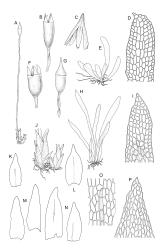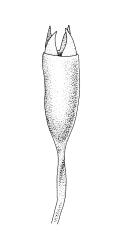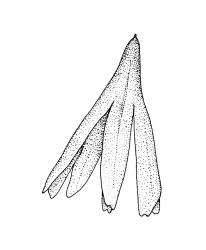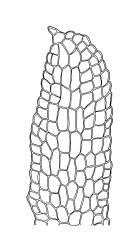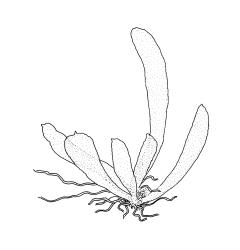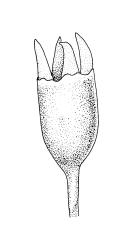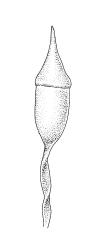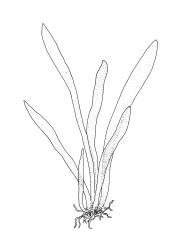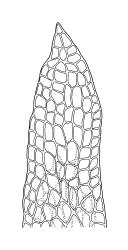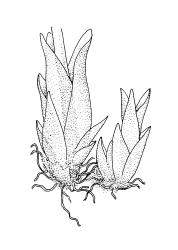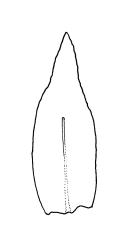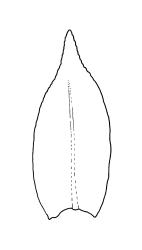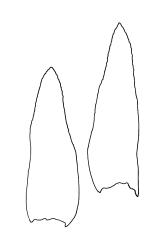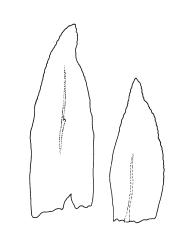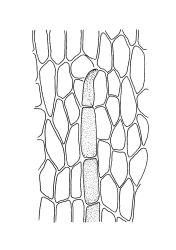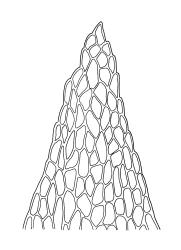- ≡ Bryum brownianum Dicks., Fasc. Pl. Crypt. Brit. 4, 7 (1801)
- ≡ Tetraphis browniana (Dicks.) Grev., Fl. Edin. 230 (1824)
Protonemal flaps green or brown, abundant or sparse, linear or spathulate, crenulate, entire, or obtusely and finely toothed at margins, rounded, obtuse, or acute at apex, with or without an apical mucro, unistratose near margins but nearly always bistratose medially, (400–)800–1500 × 75–105 µm.
Perichaetial shoots mostly <0.5 mm; perichaetial leaves to c. 1 mm, with an oblong or ovate base, tapered gradually to a rounded, obtuse, or acute apex, entire or crenulate; costa weak or rarely absent, with cells multistratose and longer than the adjacent laminal cells, extending from upper leaf to leaf base or vanishing in lower leaf, often with one or more projecting abaxial spines near the terminus. Perigonia not seen. Setae red-brown, 6–10 mm, slender and flexuose, twisted to the right (dextrorse) above or throughout when dry; capsules erect, ellipsoid, red-brown, 0.8–1.0 mm, with rim undulate or not; stomata not seen. Peristome teeth 4, c. 400 µm long, erect wet or dry. Operculum high conic, acute, c. 0.5 mm. Calyptra 1–1.5 mm, with faint longitudinal, multistratose, and raised bands of cells in lobes. Spores 9–15 µm, smooth, yellow in mass.
Nyholm 1969, fig. 427A; Crum & Anderson 1981, fig. 619; Smith 2004, fig. 38, 6–9; Harpel 2007, p. 114.
NI: Taranaki (Mt Taranaki), Wellington (several localities on Mt Ruapehu); SI: Nelson (Fyfe River in Marino Range, Hope Range, Mt Arthur?, Mt Euclid), Westland (Sewell Peak).
Bipolar. Widespread but rare in the northern hemisphere.
Tetrodontium brownianum usually occurs in rock crevices or caves, often on the undersurface of overhangs, and is usually associated with small streams or their margins. The several Mt Ruapehu (most collected by G.O.K. Sainsbury) and two Mt Taranaki (both collected by J.K. Bartlett) collections are from shady crevices in scoria. Most South I. occurrences are from granite or quartzite, and subject to at least periodic irrigation. A population from the Hope Range (A.J. Fife 7460, CHR 406869) occurred on granitic gravel in a rivulet shaded by red tussock, while one from Mt Euclid (A.J. Fife 6314, CHR 104731) occurred on "moist granite stones in [a] deep crevice; subject to flood [at the] margin of a small, cascading stream". Recorded from between c. 1310 (Mangaturuturu Valley on Mt Ruapehu) to 1675 (Mt Taranaki) m elevation on the North I. and between 620 (Fyfe River) to c. 1100 m (Mt Euclid) on the South I. Associated species include Diplophyllum domesticum, Telaranea tetradactyla, Zoopsis setulosa, and Mittenia plumula, all chasmocolous species.
Material from Mt Arthur (a limestone/marble massif) was collected by J.K. Bartlett (AK 189125) and its substrate is unknown. Occurrence on limestone would be anomalous compared to all other known N.Z. localities and to the species’ substrate preference of "siliceous or granite overhangs", both in North America (Crum & Anderson 1981) and in Fennoscandia (Nyholm 1969). The Mt Arthur locality, while not rejected outright here, deserves confirmation.
In some respects N.Z. material falls between descriptions of T. brownianum and T. repandum (Funck) Schwägr. [Spec. Musc. Frond. Suppl. 2: 102. 1824] given in northern hemisphere treatments, especially those given by Nyholm (1969, p. 653). However, the absence of abundant flagelliferous shoots (a defining feature of T. repandum) and the variability of the N.Z. material taken collectively dictates the recognition of one taxon here. Based on comparison to limited northern hemisphere material and to the literature cited above, our material is best assigned to T. brownianum.
New Zealand T. brownianum is variable with respect to the shape, number of cell layers, toothing, and development of an apical mucro in the protonemal flaps, the strength of perichaetial leaf costae, and the undulation of the capsule mouth. The strength of perichaetial leaf costae varies even within a single female shoot. In some N.Z. collections costae are more distinct in the mid to upper leaf than near the insertion and bear one or more abaxial spines; such spines have not been seen in European material available for comparison, nor are they reported by Nyholm (1969).
Populations occurring on South I. granite/quartzite tend to have shorter (less than c. 1 mm) protonemal flaps with more strongly crenulate margins and more distinctly mucronate apices than the North I. populations. In such material, the protonemal flaps are at least partially bistratose. Perichaetial leaf costae are weakest in material from Mt Euclid, which is also unusual by having an undulate capsule rim.




